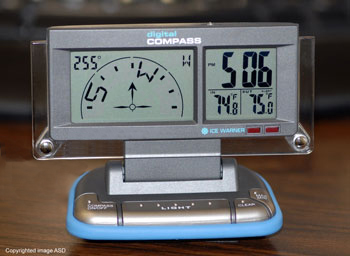- Home
- Products
- Knowledge Base
- Sales
- Customer Support
- Contact Us
- Order Desk: 866-216-8700
Welcome to ASD! Call us at 866-216-8700 to place your order today.
 |
How To Calibrate Your Digital Compass? |
||||
|
Thursday 16 January, 2014.
|
||||
|
Calibration of a digital compass is fairly simple process if you know how to force it into its calibration mode. For that you may need to refer to your device user guide. Here we attempt to explain a more general way of calibrating most digital compasses as well as very specific and accurate procedures for more popular and recent devices. Knowing how a digital compass works will always help you achieve a more accurate heading. Why is calibration necessary?Calibration is the process used with all non magnetic sensors to separate the earth's magnetic field from magnetic field distortions created by the environment into which the sensor is placed. An example of this would be the hard-iron magnetic distortions created by the engine and body of an automobile. By implementing a simple calibration routine with the sensor in a fixed position within the car, the maximum and minimum field strengths can be determined and then used to correct the sensor output for the distortions present. How often do I need to calibrate my compass?Typically the need for recalibration is due to system changes, the compass itself can go years without needing re-calibration. If the system changes magnetically the compass would need a new user-calibration. System changes which would require re-calibration include becoming magnetized, swapping out ferrous components if they are not magnetically the same or re-locating the compass or moving it to a different vehicle. Please note that every vehicle has a unique magnetic footprint or a magnetic distortion signature. Compass Installation
The performance of a compass will greatly depend on its installation location. A compass relies on the earth's magnetic field to provide heading. Any distortions of earth magnetic field by other sources such as a car massive iron components should be compensated for in order to determine an accurate heading. Sources of magnetic fields in any automobile include permanent magnets mostly in its audio speakers, motors, electric currents flowing in its wiring-either dc or ac, and ferro-magnetic metals such as steel or iron. The influence of these sources of interference on an electronic compass accuracy can be greatly reduced by placing the compass far away from them. Does the Type of Battery can effect my Compass accuracy?That depends on the type of the battery used. For instance, some digital compasses such as RP3 and WayFinder incorporate proprietary hard and soft-iron correction algorithms which compensate for the magnetic distortion effects introduced by batteries. This is especially true when using any type of rechargeable battery, as they tend to change characteristics during discharge and after each charging cycle. As to the types of batteries, Lithium has the least magnetic signature, followed by Alkaline, with NiCad (Nickel-Cadmium) having the highest magnetic signature. Do I need to re-calibrate when I change geographical locations?No, re-calibration is not necessary. Compassing is ratiometric, so when the total field strength changes the sensors change proportionately and the heading will still calculate correctly. General Calibration ProcedureCalibrating a digital compass is fairly simple task.
The RP3 Digital Compass Calibration Procedures
Calibration Procedure For WayFinder Models V1000, V2000, V2020, V7000, and V8000
Now let's start the engine and turn on all electrical accessories such as heater fan, radio, etc. and with 10 second for an stable condition.
That's it! you are done calibrating our compass. |
||||
|